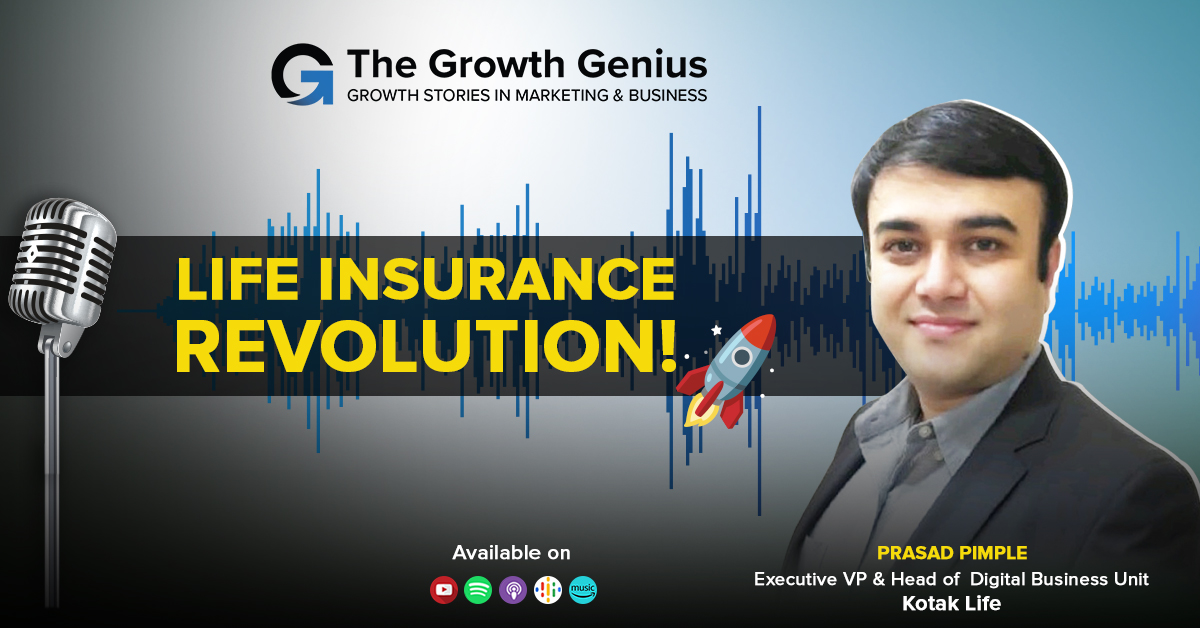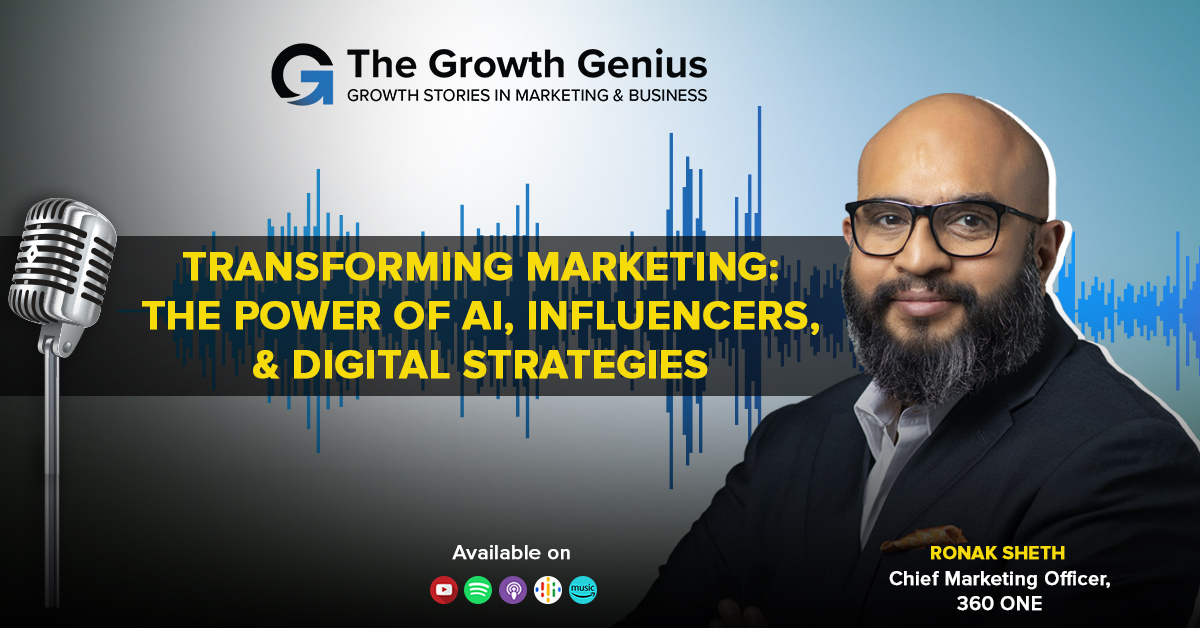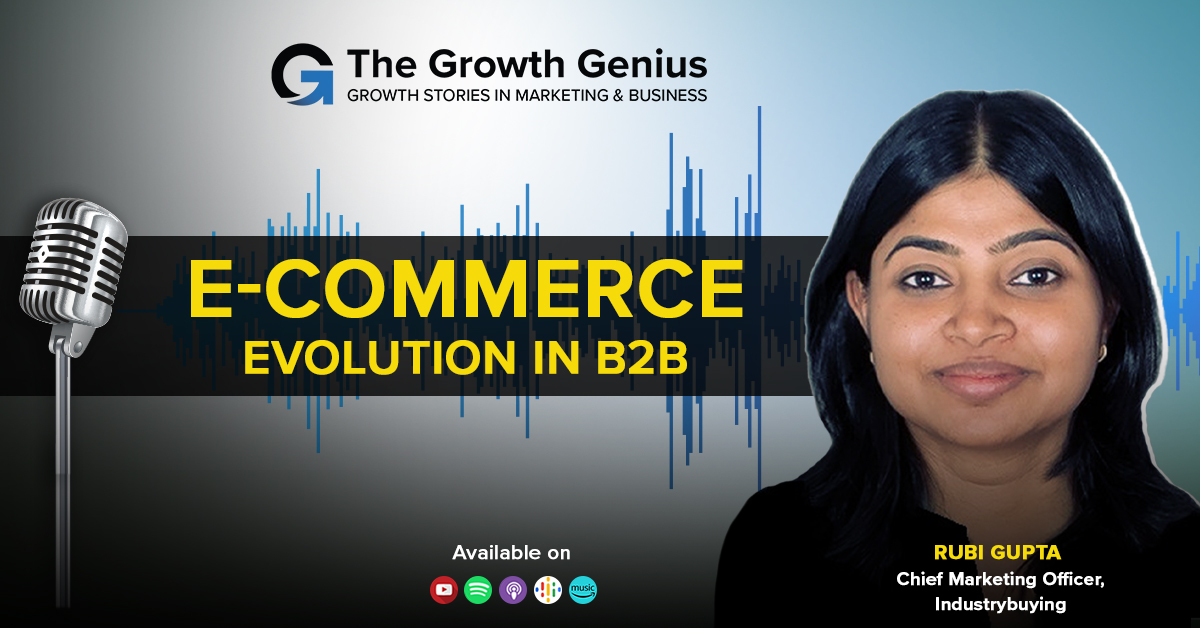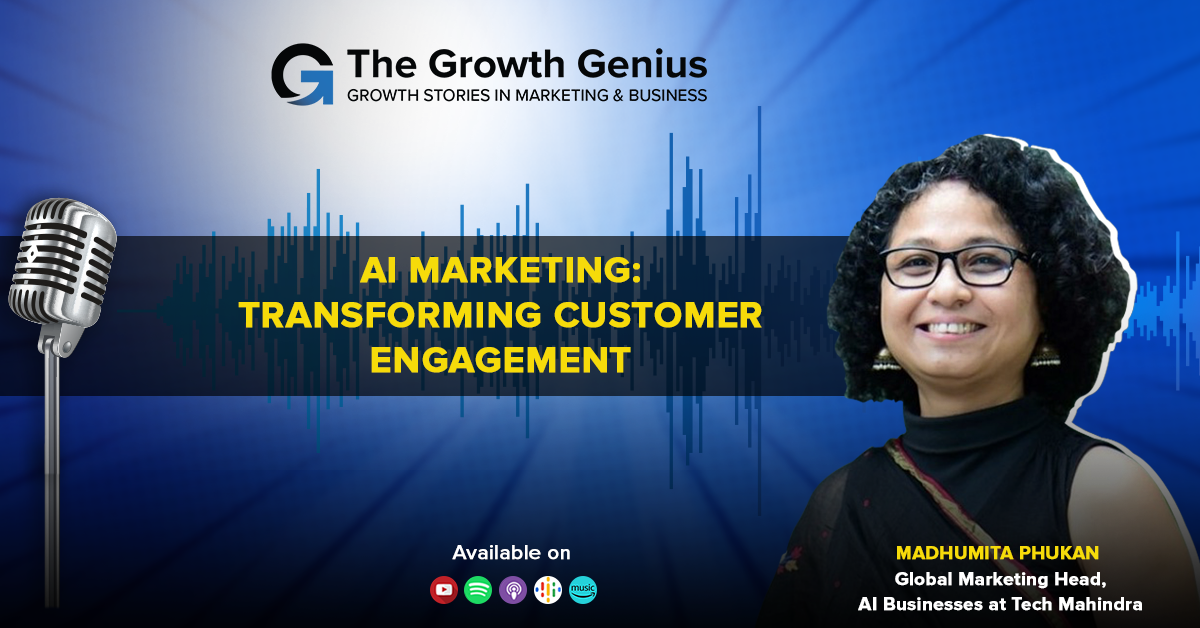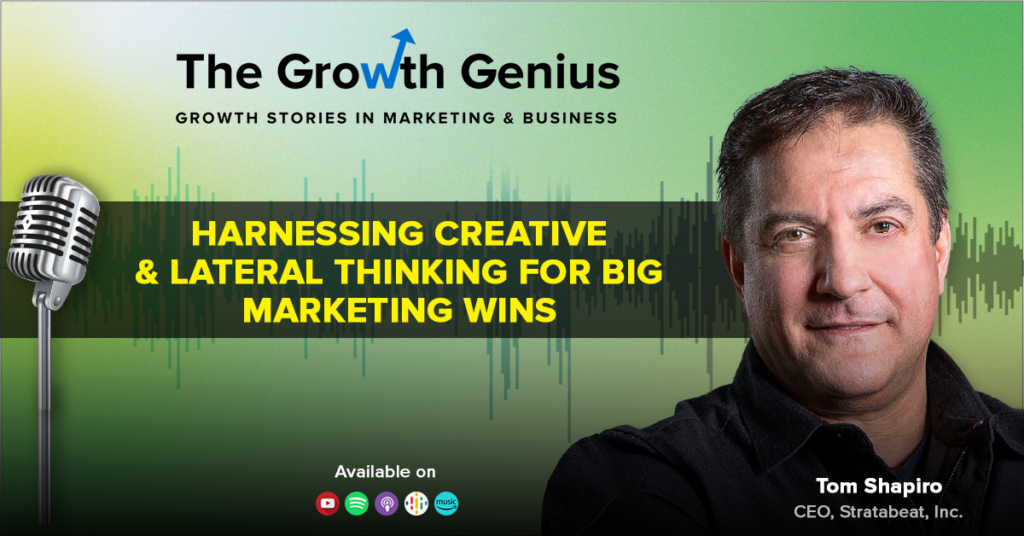
Witness an Increase in your ROI
Unlock higher rankings, quality traffic, and amplified conversions through tailored award-winning SEO strategies.
|
Getting your Trinity Audio player ready...
|
Listen on your Podcast app
Summary
In this podcast episode, Tom Shapiro, a renowned marketing expert, shares valuable insights on effective marketing techniques. He emphasizes the importance of understanding customer needs and preferences to create successful marketing strategies. Tom discusses the significance of personalization and customization in marketing campaigns, highlighting how tailoring messages to specific target audiences can yield better results. He also emphasizes the role of data analysis in optimizing marketing efforts, enabling businesses to make informed decisions and drive growth. Tom further explores the power of storytelling in marketing, explaining how compelling narratives can engage and resonate with customers. Overall, this podcast provides valuable advice and practical tips for marketers looking to enhance their marketing techniques and drive business success.
Key Take Aways
- The importance of understanding your target audience: Digital marketers should invest time in researching and understanding their target audience’s preferences, behaviors, and needs to create effective marketing strategies.
- The significance of data-driven decision-making: Utilizing data and analytics can help digital marketers make informed decisions and optimize their marketing campaigns for better results.
- The power of personalization: Tailoring marketing messages and experiences to individual customers can significantly improve engagement and conversion rates.
- The role of storytelling in marketing: Storytelling can help digital marketers connect with their audience on an emotional level and create a memorable brand experience.
- The need for continuous testing and optimization: Digital marketers should constantly test different strategies, channels, and messaging to identify what works best and optimize their campaigns accordingly.
- The importance of building trust and credibility: Establishing trust with customers is crucial for digital marketers, as it can lead to long-term relationships and repeat business.
- The impact of user experience on marketing success: Providing a seamless and enjoyable user experience across all digital touchpoints can greatly enhance marketing effectiveness.
- The value of staying up-to-date with industry trends and innovations: Digital marketers should continuously educate themselves about the latest trends, technologies, and best practices to stay ahead of the competition and deliver cutting-edge marketing strategies.
Read Transcript
Tom Shapiro:- I’ve been really interested in and focused on neuroscience, behavioral science, and human psychology and applying that to digital marketing. And so the way to be successful with marketing today has nothing to do with explaining your features, functionality, technology, methodology, history of the company, or how many offices you have; no one cares. If you focus on connecting with someone on a more subconscious level, it means resonating on an emotional level. Actually, as you know, connecting on an emotional level is a necessary ingredient in marketing. Without emotions, it’s very difficult to drive someone towards a sale; it’s difficult to get them to make that decision.
Shelly Singh:- Hello and welcome to The Growth Genius series brought to you by DMAasia and Infidigit. My name is Shelly, and I’m the country director, Americas, at Infidigit. I’m also the founder and director of DMA Asia. In this Growth Genius series, the world’s best marketers and business leaders are interviewed about the brands they have worked on, their successful campaign strategies, how they got noticed by their customers, and how they delivered better customer experiences to drive growth. In each episode, we want to share the big idea that inspires these marketers, the campaign trail they used to execute it, and how it all came together.
Today’s guest speaker is Tom Shapiro. Tom Shapiro is CEO of Stratabeat, a b2b marketing agency that drives leads and revenue growth for b2b companies. Through his career, Shapiro’s clients have included market leaders such as Intel, GE, and AT&T. Shapiro was the director of digital strategy at iProspect, and during his five years at the agency, the number of employees grew from 85 to 700 or more. With a passion for neuroscience and behavioral science, Shapiro’s insights have been published in Chief Marketer, cmo.com, CNN.com, Forbes, and MarketingProfs. Shapiro is the author of the books Rethink Lead Generation: Advanced Strategies To Generate More Leads For Your Business and Rethink Your Marketing: 7 Strategies To Unleash Revenue Growth, both available on Amazon. A very warm welcome, Tom
Tom: Thank you, Shelly; it’s great to be here.
Shelly:- Great. So to start with, tell us about your background and how you got started in marketing.
Tom:- Sure. So I actually started many, many years ago; it was back in 1994, several years before even Google existed, and at the time the web was brand new to everyone, so there were very few people who could access it. It had very slow connections; the first website that I built was in December of 1994, and, you know, Yahoo at that time was a simple directory with a gray background. It was a completely different world back then. That was how I entered the marketing world, and I’ve been in the digital space ever since, and so I’ve seen a lot of evolution through the years, a lot of greater sophistication obviously with Google and SEO. And so I’ve been both on the client side as well as the agency side, and at one point I joined a company, as you mentioned, helping them grow from 85 employees to over 700 plus. That was an SEO agency called iProspect. And it was really interesting because when we started talking, we dealt with a lot of Fortune 500 companies, and when we started talking with them, they had absolutely no idea what SEO was, how you could use it, you know, how you could use content to actually acquire new customers, and so it was just about the wild west; it was brand new for everyone. And then after that, I really felt like I wanted to approach clients with a broader toolbox—not just SEO but many different tools—in order to help them build their businesses.
And so that’s why I started Stratabeat, and we’re strictly focused on b2b businesses, right? And what we’ve seen through the years is a deep sophistication in the areas of not only SEO, content, and b2b websites, but also in the way that you analyze the performance of digital. So for example, just as one example, you know, we’ve seen a lot of deeper analysis in the areas of behavioral analysis, whether that’s looking at actual video recordings of test users, actual users on your website, or things like that, and so that’s what has brought us here today. I’d say one thing that has made my path a little bit different than some other marketers is that I’ve been really interested in and focused on neuroscience, behavioral science, and human psychology and applying that to digital marketing, whether that’s building a new website, building new content, implementing conversion optimization, or implementing SEO. It doesn’t matter; you know, we apply neuroscience and behavioral science to absolutely everything that we do, and here I am today.
Shelly:- Well, that’s great. So considering your experience in the digital space since before Google was even founded, how have you seen marketing evolve through the years, and how do you see it evolving at the current time?
Tom:- Yeah, so back when I started, before Google even existed, there was a lot of me marketing. And what I mean by that is, you know, companies were really focused on talking about themselves, right? It wasn’t really about storytelling; it wasn’t about really identifying ways to reach the audience on a subconscious level, on a deeper level, and move them to action. It was much more just about talking about what you did, what you sold, talking about features, etc. And what has changed a lot through the years is that there’s, I think, a deeper appreciation for everything that needs to be customer-centric; everything needs to come from the customer. And it’s all about, you know, when someone comes to your website, they’re very self-interested; they’re thinking, you know, what’s in it for me, and so the way to be successful with marketing today has nothing to do with explaining your features and functionality and technology and methodology and the history of the company and how many offices you have; no one cares. You know, it’s a completely different landscape where you really need to engage with your audience on a deeper level. It has to be very customer-centric and even customer-obsessive, right? But I’ll give you an example: if you focus on connecting with someone on a more subconscious level, it means resonating on an emotional level.
The neuroscientist Antonio Damasio ran studies where he found that people who had damage to the part of the brain that triggers emotions—in other words, they couldn’t feel happy, they couldn’t feel angry, or sad—had an extremely difficult time making any type of decision, including purchase decisions, because they would endlessly waffle; they couldn’t feel strongly enough about product A versus product B versus product C, and so they would endlessly waffle. And so what he concluded was that without emotions, it’s very difficult to drive someone towards a sale. It’s difficult to get them to make that decision to choose your product, your service, or your solution, and so, actually, connecting on an emotional level is a necessary ingredient in marketing. And so what you see today if you look around is , you know, much more sophisticated landscape of brands actually connecting on a more authentic level and a more subconscious level than say a decade ago, 20 years ago or even 30 years ago
Shelly:- Yeah, that’s very right. So why are creativity and lateral thinking so important in marketing today?
Tom:- Yeah, so this is really interesting, right? Through the years, we’ve become more and more data-centric, and I’m a total data junkie, so I’m with everyone in terms of optimizing like crazy. Right, we want to optimize our marketing like crazy, but here’s the problem: if we’re trying to optimize what’s mediocre, then we get optimized mediocrity, and that doesn’t do anyone any favors. It doesn’t help you market, it doesn’t help you sell anything, and it certainly doesn’t help your audience. And so what’s really critical is breaking out of the pack. Consumers are consumers, and b2b buyers today are inundated with information. Everyone, every individual, is dealing with information overload, and so when you’re hit with literally 5,000 marketing messages a day or 6,000 marketing messages a day, how does your brand cut through all the clutter to beat your competition to really stand out, capture their attention, captivate them, and then resonate beyond that so that you drive them to action? And so it’s really important that you lean on creativity, that you lean on lateral thinking, that you lean on marketing innovation, and that you lean on something new and different in order to break through the pack. If you’re like many brands where you’re looking at the competition and so you see the competitor do something interesting and so you copy them, you do what they’ve done because you see they’re successful, well, you know, that’s challenging for you to be successful at what they have done because one, they have probably spent months and months planning this out, two, you’re a copycat brand at that point, right, you’re not differentiated as much, and it’s the same if you’re doing what you did last year and the year before, which most companies do. They might tweak around the edges, but they don’t really have a backbone and do something completely new. What happens is that you limit yourself with all of these tactics—looking at the competition, doing what’s hyped by the media, doing what you’ve done in the past—you know, all of these are void of creativity They’re void of creativity, right? And those paths lead to mediocrity and undifferentiated brands. So necessarily, creativity, lateral thinking, and marketing innovation are the keys to marketing success.
So I wrote two books, “Rethink Your Marketing” and “Rethink Lead Generation,” both available on Amazon. In both of the books, I proved through, in the first book I had over 50 case studies. And in every single case study, 100% of them, it was creativity and lateral thinking that drove the success. Yes, they might have been very digitally oriented, they might have been very data-centric, but it was through creativity; it was through doing something very radically different, so having a backbone and putting all their chips in the middle of the table, that’s what drove the success. And so, you know, Shelly, we can talk today about different examples of this, but it really is the creativity, thinking, lateral thinking, and marketing innovation that drive success; it’s not following what your competitor did last week that looked successful.
Shelly:- That’s something new to learn from you. And so why is following best practices one of the worst things that you can do in marketing?
Tom:- Yeah, so we talk about best practices all the time; you hear people talking about it all the time, and you’re absolutely right. I feel that it’s one of the worst things that you can do because it is the polar opposite of applying creativity to your marketing. So what do I mean by that? Well, when you apply creativity and lateral thinking, you’re coming up with something new, right? You’re coming up with things that others are not doing, but by following best practices, and I hear this all the time from many, many marketers, “Oh, you know, we’re an agency that follows best practices; we can guide you through best practices; we’re experts in this field, and well, you know, we follow best practices”, that’s horrible,; it’s really horrible because it leads to mediocrity, right? It leads to doing the same things as your competitors. If everyone in your industry and your top competitors are all following best practices, and they probably are, imagine how difficult that makes it for a buyer because they’re seeing five or six different companies that they’re evaluating and all of them are pretty similar, all following best practices. How are they going to make a decision? So the way that you can cut through all the noise, differentiate yourself, and stand apart and above the competition is through creativity. It is not through following best practices.
What you should do is bust through best practices; you should dismantle best practices and create new practices that are even better and that produce better results that shock the world, right? That’s how you drive massive results. If you want 5% incremental improvements, fine; you know, best practices are for you, but if you want to double your results, if you want to triple your results, you must do something beyond best practices
Shelly:- That’s so true. And what are some real-world examples that showcase the power of creativity in marketing?
Tom:- Sure. So think about this: I love this example of Salesforce, the multi-billion dollar software company that is massively successful,; everyone knows them as an 800-pound gorilla today, but actually at the time that they started, they were just you know, less than a handful of people;they’re v ary scrappy startup, and so what did they do to grab attention? So the 800-pound gorilla at the time was Siebel Systems in the CRM space, and so Salesforce bought out all the taxis in the area in San Francisco when Siebel Systems was having their annual user conference. And so anyone who came to the airport looking to go to the Siebel Systems conference wound up in a taxi driven by Salesforce people. It’s just that the Salesforce people gave them a pitch on Salesforce and why it was so important and why, you know, their software was so much better than the Siebel model, and then beyond that, at the users conference itself, Salesforce set up a mock demonstration where the crowd was demonstrated; they were protesting software, the, you know, enterprise software, right? And they were saying no software, and because Salesforce was all about being in the cloud and that was very brand new at the time, the whole idea that you wouldn’t download the software, that you wouldn’t install it, that you wouldn’t manage it yourself was brand new, and so Salesforce made a mockery of the whole thing, this mock protest, and they had a mock TV crew covering it. And so there was so much attention drawn to it that actual TV crews started showing up because they saw one TV crew and didn’t want to miss out on the news, so they brought their own TV crew. So all of a sudden it was all over the news, and it was a massive success, and obviously Salesforce is massively successful.
Now that’s a drastic case of creativity, but it doesn’t have to be expensive, and it doesn’t have to be world-changing. I’ll give you an example. So at one of the companies that I was at, we had been targeting many different types of companies and many different industries, and we decided that our best customers were software companies, and software companies would deliver six-figure contracts, and they needed to renew over and over for the types of services that we provided, which were localization services for their software. And so what we decided to do one day was to fire, literally, 50% of our customers in one day, and then we decided we were only going to focus on software companies; that’s the only thing we’re going to market is solutions for software companies, and we’re going to ditch all other marketing. And we wound up growing the company by 250%, and the company wound up being sold for multiples of its annual revenue. It was a massive success, but it was only because we had the backbone to be creative and do something very bold that others were not willing to do.
For something at iProspect where we went from 85 employees to over 700 within five years, one of the things that we did was look around and say, “Okay, well, how do we do our marketing?” At the time, the vast majority of the marketing was at large conferences. With thousands of attendees at these conferences, we would have a booth, an exhibit booth, and we would spend literally $40,000–$50,000 at each of these conferences, sending a whole team, having the booth, flying everyone out there, and flying all the equipment out there. And so myself and a colleague said, “Well, you know, what if instead of” and I should say before I explain, so one of the challenges with doing this, right, it might sound fantastic going to a conference with thousands of prospects and, you know, having the whole team there, but the problem was our competitors were right next to us. So we would have a booth, but guess what? Theretoo, were 30 other competitors who would have a booth too and it was very easy for someone to have a conversation with us, but then to have 29 other conversations with competitors. And so, you know, we were spending a ton of money, a ton of effort, and a ton of resources only to have someone talk to 29 of our competitors and hardly remember us. We might have had a great conversation, but they might have had a few other great conversations as well, right? And so the entire environment was not set up for us to break through, right? And so we said, Well, that would be the environment that would be completely different from that where it could still connect with our best clients, but instead of thousands of attendees and two-minute conversations, what if we could have two-hour conversations with our best prospects and no competitors?” And we thought, Well, how could we do that? How could that be, because that would be the ideal, and that would solve all of these challenges of trade shows, conferences, and seminars? And we said, You know what? We’re going to host our own events, gonna be local events, so we rented out space at the House of Blues in a back room, so we made it really fun, right? Tons of food, tons of alcohol, and we invited only who we wanted to attend. And so we got our best prospects in the door. You know, with lots of food and drinks, we had a special guest from Google come in and speak, and we had a fantastic time. Now there were only 10 attendees, right? There were only 10 guests in the room with us, but we wound up talking with them for hours and hours, and it was fantastic, and out of that one night, we wound up with a multi-million dollar contract and a six-figure contract. And so we said, Let’s do this again, and at the second one, the same thing happened; we wound up with another multi-million dollar contract. So we were like, Wow, this is amazing; this is completely different from going to these large shows and competing with, you know, 29 other competitors. And so we wound up doing these very intimate events with only those who we invited, and it wound up changing everything, and that was a huge driver for our growth. It became the number one lead driver for the company and drove us from 85 to over 700 employees within five years. It was a rocket ship of growth, but it took lateral thinking—thinking about something that none of our competitors were thinking of at the time.
Shelly:- Very creative. So are there any techniques for a marketing team to become more creative and innovative?
Tom:- Yes, there are. You know, it’s funny because sometimes when we talk with prospective clients, they worry, “Oh, well, we’re not a very creative team, right? so we’re not a creative marketing team”, and I always tell them, “You are; you just need the right techniques, right? You need the right methodologies and techniques to untap that, to extract it from your minds and from your hearts.” And so, for example, going back to the example where we did the local road shows, the intimate events, and helped iProspect go from 85 to over 700 people, that was a framework that I call doing the opposite. Do the opposite. So whatever marketing you’re doing today, what if you did the opposite? So for instance, iProspect was spending $50,000 a shot at these massive trade shows and then sending, you know, 10 people and being, you know, right next to 29 competitors.
Shelly:- Yeah.
Tom: Okay, what’s the opposite of that? At the local intimate events where we select who’s going to be there, there are no competitors, and instead of two-minute conversations, we have two-hour conversations So that was a framework for using the opposite approach to break through and have breakthrough results. So that’s one way that you can do it: think, Okay, what’s the marketing that we’re relying on today? What if we did the exact opposite? And it might sound silly; it might sound absolutely crazy, but it really works because no one else thinks like that or is willing to do that.
So another framework, besides the opposite, is cross-pollination, right? You take ideas from different industries, mash them together, and come up with something brand new. There have been studies done, really interesting studies done, that looked at the number of patents that were being awarded in the United States in different cities, and what they found was that cities that had a higher population of immigrants were producing more patents, and the reason why is because you have this merging of cultures, you have a merging, you have a cross-pollination of ways of thinking, of history, of experience, and it produces this new innovation, right? This new collaboration with new ideas, you merge it together, and it helps you be more innovative. And so, you know, cross-pollination, doing the opposite, and also brainstorming, so one thing that I find really interesting is I that I ask companies how much time they devote to brainstorming new ideas and innovation. And this is the marketing team, right? I’m not talking about product development; I’m talking to the marketing team. How much time do you spend on this? The typical answer is maybe 1%, right? Maybe 1% of their time. Most of it is on doing; it’s on the busy work of the day-to-day. There’s very, very little investment in thinking of the new, in thinking of what’s next, what’s around the corner, and where we need to be 12 months from now. And if your team spends three times as much time, let’s say, this coming quarter on innovation and innovative ideas—what’s new, what can you do that’s new—you will be more innovative. You’re focused there; you’ll come up with more ideas.
Now here’s the misconception with innovation: a lot of companies think it’s just this aha moment; you just have one aha moment; you have a light bulb moment, right? That’s not real innovation. Stephen Johnson has an amazing TED Talk; he wrote a book called “Where Great Ideas Come From”, His TED Talk has been watched millions and millions of times. His book is amazing; I would strongly recommend it, and what he talks about is the iterative nature of innovation and how all major innovations throughout history relied on prior innovations. They rely on prior ideas, then incrementally improve them, and it goes from one idea to the next. It’s not that you have a group of people who shut the door in a conference room and, for one hour, come up with a brilliant idea, right? It’s that you lean on the ideas you had in your last brainstorming session and the one prior to that. So what I’m saying is, develop a system, a process, and a system where you make innovation part of your DNA; you make brainstorming part of your DNA; it’s part of what you do as a marketing team. And instead of just having one brainstorming session for the year, which a lot of companies do, have one every month, right? Have them all the time, have them consistently, and be consistently innovating, consistently looking around, and consistently gathering and sharing ideas.
One of the things that we did when I was at iProspect was that every single week our digital strategy team would talk about new ideas, and it really helped us come up with completely new ideas. One of the things we brought to the table was that we said, “Well, look, we only have like five or six case studies for the entire company; our clients were very happy; we just didn’t have documented case studies.” So our digital strategy team said, “What’s a way to break through and have a hundred case studies? How could we? Instead of five or six, how could we have 100 at our fingertips?” And so we said, you know, what we’re going to do is go around, interview the client account teams, document everything, and then slice and dice and atomize the case study. So from one account team, instead of just having one case study, we might have five, six, or seven case studies, right? And we went around on a blitz, and we did this account team after account team after account team. We built a database so that it was indexable and you could find everything, and we wound up reaching 100 case studies within months. And so, you know, it’s all about how much time and energy you are really devoting to the new, to new ideas, right? to innovation, to lateral thinking, to creativity, and if you’re not spending the time on it, It’s not going to happen.
Shelly:-Right. So you were talking about cross-pollination; does this work for b2b clients as well?
Tom:- Absolutely. So Stratabeat is a b2b marketing agency; we only deal with b2b clients and, you know, cross-pollination, but, you know, we rely on that quite heavily. And I would say b2b; you know, with b2b, we have to stop thinking that b2b needs to be boring, right? Like historically, yes, Iknow,w like 20 years ago,o b2b was very boring,g bu , you know,really,y the people who purchase on the b2b side are a human being;, they are peopl;, they’re individuals, righ?. They’re no different than consumers because in the evenings and on the weekends, guess wha?,Theyy areconsumers,s and so we tend to think today instead of focusing on “b2bmarketing,g” focus on marketing, righ?. Focus on connecting with your audience,e an, yes, they’re in a b2bsetting,g bu , you knowe in a b2bsetting,g you’re typically selling to like five or six people at a time, righ?. You have your maincontact,t where you have the executive decision-maker, the financial decision makere the technical decision maker, the influencer,andeall ofl thes.,Youu have a team, righ?,Andd you need to market to each of them in slightly different ways. The executive might need to understand the ROI or the business impac;, the financial decision maker is going to be looking at the bottom line an , you know, the payment terms and things like that;t and you have to figure out how to appease the technical buyer so that they understand it’s not going to be disruptive and that integration is going to be easy. S , youknow, there are, lots of different considerations for the different buyers,s and so I would say that whether it’s b2b,b2c, or, whether you’re selling to the government, it doesn’t really matter;,today,y cross-pollination really works with any audience. It’s a very powerful way of doing marketing.
Shelly:- I have one more question. So you are also focusing on behavioral science and neuroscience, so how do neuroscience and behavioral science work with SEO? Let’s say, how does it work with that?
Tom: Yeah, absolutely. So, one of the things about SEO that we care deeply about is getting people to take action. So in other words, it’s not just about getting rankings in Google; we could do that and not have a business impact, right?
Shelly:- Yeah.
Tom:- But what if instead we’re focused on business impact? Yes, we’re going to drive SEO results, but we must also drive business impact at the same time. Well, that necessarily involves the experience after they hit the page, so yes, we need to rank in Google, and yes, we need to attract the click and drive them to the website. We drive organic traffic, but once they’re on the site, we need to make sure that it fulfills their search, right? Is it fulfilling the intent of their search, delivering the right experience, and driving them to action? And so what we want to do is look at the experience once they land on the page; we look at, you know, click mapping, heat mapping, attention mapping, and scroll depth on the page. If we understand the scroll depth, then we can identify which CTAS on the page they’re looking at, what they’re seeing, and what they’re not. There might be important CTAS on the page that they never see if we’re looking at scroll depth, right? And so we also look at video recordings to see if there is any friction in the experience when they’re on the website.
So, I’ll give you an example. For one of our clients, we developed a wizard, and so this was a process where maybe it was like a nine-step process to go through the steps, and there was a good conversion rate on going through the wizard. However, what we noticed in the video recordings is that at one point you’re asked to enter a date and one of the users was trying to manually type in the date. Well, when we developed it, you couldn’t do that; you had to select the date from the calendar widget, and we noticed a number of people getting frustrated because they were trying to type in the date. And so we immediately jumped in and changed the wizard so that, yes, you could either type in the date if that’s what you wanted to do or you could very easily, you know,use the calendar widget, which I thought was a lot easier than if you wanted to manually do it.
Shelly: You are giving the customer the choice, right?
Tom: Yes, they can do whatever they want. And then the conversion rate skyrocketed further.
Shelly:- Wow. Very small, but very effective.
Tom:- Exactly, and there’s no way like Google Analytics data or Adobe Analytics, they will not reveal that, like you really need the behavioral data, you need the video recordings to see that, even heat mapping and click mapping don’t reveal that. And so you need the video recordings for that. It’s more qualitative in nature, right? And so when we talk about creativity and SEO, we want to think more holistically about SEO.
SEO has traditionally been all about getting Google rankings and organic traffic. The way we like thinking about it is that it is the entire journey all the way to the finish line, and are we delivering the right traffic to the right page with the right experience and the right result? And I’ll give you an example. So we had a client who came to us and they were bragging about tdriving organic trafficheir resource library, and they were pointing to Google Analytics, and they said, See how many page views we have. We have lots and lots of page views; we have, you know, lots of organic traffic; this resource c centeris a gold mine, and we said, “Well you know, let’s apply b behavioral analytics and let’s see the experience.” So we added a behavioral analytics tag to those pages, and what we uncovered was that the resource center was actually doing a lot of damage to their brand and to their business, and you might say why? It was getting lots of page views, which is a good thing, right?
Shelly:- Yeah.
Tom:- No, it wasn’t, because they were driving lots of people to a horrible experience. The people who came to the resource center hated it. But you can only reveal that through behavioral analytics, and so in that case, we would argue SEO is not working because it’s not driving the right result for the business. And so we went in, and I mean, we increased their organic traffic by over 100%, so we doubled their organic traffic within one year, but more importantly, what we did was enhance and improve their resources, the assets that they were offering, and the types and experiences that their audience came for. So, you know, in that way, you want to think more creatively and holistically about something like SEO.
Shelly:- Wow, that’s very interesting. Yeah, you’re so right. So my next question is about your books. So you have written two books, “Rethink Lead Generation” and “Rethink Your Marketing”, so tell us how your books are different from any other marketing books and why someone should buy them.
Tom:- Yeah, sure, sure. So “Rethink Lead Generation” is the one that came out most recently, so it came out earlier this year, and so the reason why “Rethink Lead Generation” is different from all the other marketing books out there is because there are a lot of fantastic marketing books, but it’s different. So “Rethink Lead Generation” is all about creative ways, innovative ways, and ways to apply lateral thinking to your marketing, right? And we look at organic marketing, so we’re not talking about advertising, we’re not talking about sponsorships, and the book does not go into any examples of paying to play. It’s all about how you can organically grow as a brand through creativity. And we look at your website, we look at connecting with your audience, we look at SEO, we look at content, we look at referrals, we look at account-based marketing, and so we look at all these different ways to market to your audience and then say, okay, well, this is how the industry typically does it, but how do we do it? How can you do it differently? How can you do it more creatively and get better results? And so that’s one way that the book is very different from other books.
The other thing I think is just how actionable it is, and what I mean by that is that the feedback that I’ve gotten is that over and over and over again, readers are telling me, and you can even read the reviews on Amazon, that they say the same thing: Wow, I can’t stop taking notes. I’m filling the pages with notes because I want to remember everything on every page. I think that a lot of marketing books will have one central concept, and if you read the first chapter, you kind of know what the whole book is about. Whereas with this book, it really is, and if you read the whole thing, you will walk away with probably 100 new actionable ideas for your business. It’s that in-depth, it’s that heavy in content, it’s that granular in recommendations, and, you know, just actual things that you can learn on every page as opposed to just being one concept and kind of running that through the entire book where, you know, you don’t really learn additional things along the way.
Shelly:- Well, that’s wonderful. This brings us to our last segment. Tell us about any one passion you follow other than your business and writing books and how it helps elevate your profession.
Tom:- Yeah, so that helps enrich my profession I would say it’s reading. I love reading; I’m a voracious reader. I read online all the time. I read on Twitter all the time, but I also read books all the time, and it’s funny because I’ll never forget the day that I was—actually, it was my first day on the job; this was years and years ago in a different life—and I walked in with a whole box of books that I wanted on my desk. It was probably like 25 books I wanted on my desk, and one person in the elevator looked at me and said, “You’re never going to have time to read any of those.” And I thought, No, I’m not going to make the time to read these.
Shelly:- Yeah.
Tom:- Right. So it’s a choice; it’s prioritization, but to me, I can’t imagine not reading, right? And so to me, reading all the time, reading every week, and learning all the time from others is just so valuable that I can’t imagine not doing it.
Shelly:- Yes, yes. That’s wonderful. I know that you can never stop learning, right? There’s so much to learn about and to improve on every day, so that’s great. How can our viewers find you and connect with you?
Tom:- Yeah, sure. So you can go to our agency’s website, Stratabeat.com, which is one way to find me and to find us. Another would be my personal website, tomshapiro.com, or, you know, connect with me on LinkedIn. Let me know that you watch this podcast and, you know, connect with me. That would be fantastic to hear from you there. I’m also on Twitter at twitter.com/TomShapiro, and so, yeah, any of those ways would be fantastic.
Shelly:-Great. So where can they buy your book? Amazon?
Tom:- Amazon, please go to Amazon; if you type in “Rethink Lead Generation,” it’ll pop right up at the top, and yes, please buy the book. If you enjoy it, it would mean so much to me if you would leave a review.
Shelly:- Great, that’s wonderful. So thank you so much, Tom, for your time today. Your actionable insights will surely make the listeners rethink their marketing strategies. Thank you so much.
Tom: Thank you, Shelly; it’s been so much fun.
Shelly:- Great. So to all our viewers, thanks for listening, and please subscribe to this channel. If you enjoyed this episode and would like to help and support this podcast, please share it with your friends, post about it on your social media, and leave a rating and review. I’ll see you next time in a new episode with a new speaker. Till then, peace.


